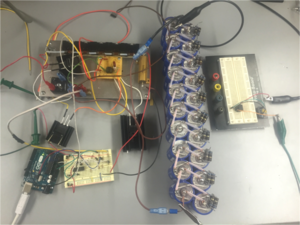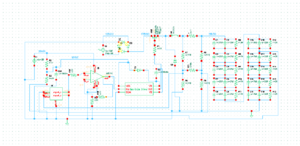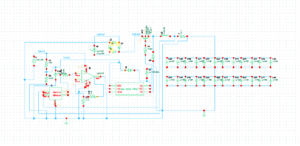Airport Battery Charger
| First Prototype | |
| Sponsors |
|
| Team Name | AirCap |
| Duration | Spring 2015 - Fall 2015 |
| Faculty Advisors | |
| Students |
|
The goal of the project is to create a device that can gather enough energy in two minutes to charge a cell phone. This product is intended for travelers who are short on time and are in between flights and need to charge their cell phone. This device should be portable and user-friendly.
Problem Definition[edit | edit source]
Background[edit | edit source]
People traveling through airports do not always have time to stop and fully charge their cell phone. A device that can gather and store the energy required to charge a battery in two minutes would make it easier for people in between flights to ensure that their cell phone battery stays charged.
Deliverables[edit | edit source]
A device that will gather enough energy in two minutes to fully charge a cell phone battery.
Specifications[edit | edit source]
- Project Specifications (As of 2/20/2015)
- Length: 6-7 inches
- Width: 4-5 inches
- Weight: Approximately 6 oz.
- Power Capacity: 5.33-7.2 W/H
- Capacitance: Approximately 1.82 Farads at 120 Vrms
- Needs to carry a charge for twice the time it take to charge the phone. (About 3 hours)
- Discharge Time: 80 minutes
- Two minutes to charge device
- Create a USB interface for the charger based on USB specifications
Project Learning[edit | edit source]
Client Interview[edit | edit source]
- Wrote a list of technical, budget, and miscellaneous questions for client to make sure we approached this project fitting our client's needs
- From the answers we obtained, we were able to build a better foundation for starting this project
Lead Instructor and Technical Advisor Meetings[edit | edit source]
- Every week we meet with our lead instructor and our technical advisor to go over the progress of the project
- Topics such as due dates, technical progress, budgets, and brainstorming are all discussed during these meetings
Calculations[edit | edit source]
Looking at the values of a li-poly battery for a cell phone, we found the following:
- 1. Voltage was 3.7 volts
- 2. Current storage/use was 1.4 Ah (amp/hours or 1400 mAh).
This ended up being 5.18 watt/hours for the cell phone battery (voltage*Ah). Since a watt/hour is equivalent to 3600 joules we ended up with a calculated value of 18,648 joules of energy storage in a cell phone battery (5.18 watt/hours×3600 joules = 18,648 joules). This was our baseline for calculating the energy storage needed for this project.
We began this project with equipment from a previous project, most notably the supercapacitor bank setup (1st prototype). This capacitor bank has 20 supercapacitors (Maxwell BCAP350), 350 Farads each with two capacitors and a 39-ohm resistor in parallel and five of these capacitor/resistor parallel circuits in series (See 1st prototype schematic) for a total capacitance of 70 farads, approximately 1 ohm of resistance and an energy storage of 26950 joules (using equation 1 below).
- U (joules)=12C∗𝑉2 (Equation 1)
The Maxwell BCAP350 supercapacitors are limited to 2.7 V across the terminals. With 10 of these circuits in series we were constrained to 27 V (rounded up to 28 V for simplicity – within specifications, these supercapacitors are very tough - they can handle 35 A each and at least a 10% increase in voltage above 2.7 V).
With the constraint of charging the supercapacitor bank in under two minutes, the calculation of energy required/stored, the amount of farads in the supercapacitor bank available (70F) and the amount of voltage required across the supercapacitor bank (28V), we next needed to determine average amperage.
We picked an average current value of 17 A. This would theoretically get the capacitor bank fully charged within 53 seconds from 𝑊𝑎𝑡𝑡=𝑗𝑜𝑢𝑙𝑒𝑠𝑠𝑒𝑐𝑜𝑛𝑑→𝐽𝑜𝑢𝑙𝑒𝑠𝑉𝑜𝑙𝑡𝑠∗𝐴𝑚𝑝𝑠=𝑡𝑖𝑚𝑒(𝑠𝑒𝑐𝑜𝑛𝑑𝑠)→26950𝐽28𝑉∗17𝐴=53(𝑠𝑒𝑐). From this average amperage value, we were then able to calculate the inductance value of the inductor, the voltage of the inductor, the current swing and the max switching frequency.
We used the following equation to determine the above values:
- 𝑉𝐿=L∗𝑑𝑖𝑑𝑡 (Equation 2)
120 Volts ac, when rectified, ends up being 169.7 Volts dc, hereafter 169 V dc →120𝑉𝑎𝑐∗√2=169.7𝑉. With 169 volts DC, the voltage of the inductor would then need to be 169-28 = 141 V DC (V.L in equation 2).
Looking at the market for available power inductors (also called power chokes) – it became evident that an inductor greater that 4.7uH was not readily available, especially with the amperage requirement of this project (minimum of 17 A average). In addition, inductors grew in size substantially with increased inductance (we were trying to keep the design size small). Inductor manufacturers were contacted and it was discovered that a one-off run was expensive and/or not generally available. The earliest lead-time for some inductors was 24 weeks.
Searching all suppliers, the Wurth 4.7uH inductor was finally selected (see attached product sheet). This Wurth inductor is rated for 30A but can handle amperage up to 78 Amps.
Using the inductance of the Wurth inductor, we then determined the current swing, and max switching frequency.
Using equation 2, above, and the inductor voltage and inductance value we eventually decided upon a 10 A swing (di) and at switching frequency of 500 KHz (1/dt). This would require 5 of the inductors, in series, for a total of 23.5 uH.
Design[edit | edit source]
Buck Converter[edit | edit source]
In order to create a rapid, charging circuit, we would need to rely on a familiar layout that would rectify ac voltage to a dc value and then convert the dc value to a particular dc value needed for a supercapacitor bank. Upon recommendation from our mentor, Professor Hess, we decided upon using a buck converter.
This buck converter would then be intended to be used a current source; this means that we wanted to sense the current and have a current swing so that the average current would be of a sufficient value to allow for a rapid charge of the supercapacitors.
Isolated Gate Driver[edit | edit source]
Due to the high input DC voltage to the buck converter, a special type of gate driver, the isolated gate driver, would need to be incorporated into the project design. This gate driver is considered a charge pump, charge elevator or level shifter and works by means of charging a capacitor, the bootstrap capacitor, and switching the leads of the capacitor to turn the N channel power mosfet off and on.
Microcontroller[edit | edit source]
In order to control the current and to allow the buck converter amperage to swing above or below our average current, we would need a microcontroller that would sense the current. This would be the brain of our feedback circuitry.
Sensing the current would be achievable via a resistor. With the current passing through the resistor, a voltage would develop across the resistor. The microcontroller then would read the voltage on one side of the resistor and subtract the voltage from the other side of the resistor, to get a voltage difference. The microcontroller would compare this value with code and either open or close the N channel mosfet switch.
Looking around for different microcontrollers we settled upon the Arduino Uno. This microcontroller has the ability to sense analog voltages and has a decent processing speed of 16 MHz. This microcontroller also had headers that allowed for solderless connections.
With the microcontroller selected, we then needed to drop down voltages for feedback. This was done via two voltage divider networks. In addition, we were needing amplification of our input signal; from the microcontroller to the N channel mosfet. This was achieved by an operation amplifier (CD4007 – see product data sheet). The isolated gate driver required a minimum of 10 volts for switching and the output of the microcontroller was only 5 volts. We needed a gain of 2 Volts/Volts. This was achieved by using a noninverting operational amplifier layout and an Rf and Rin value of 1 Kohm.
Future Work[edit | edit source]
The following are problems that need to be addressed in the future:
- Getting the isolated gate driver to work properly – Under voltage lockout? Incorrect size of Bootstrap Capacitor? Circulating currents from charging supercapacitors? Interference with power supplies? Do we need a power supply with enough DC voltage and amperage to test circuit (170 V dc with up to 27 Amps)?
- Miniaturization – need smaller components (inductors especially - some have up to a 24 week lead time)
- Assembly of 2nd prototype – printed circuit board and surface mount components picked and assembled. Install of Vishay supercapacitors.
- Possible thermal issues with surface mount components (especially the N channel power mosfet)
- Feedback isolation for microcontroller. Needs op amps or other isolation on voltage divider input signals.
- Feedback code or circuit for shutting microcontroller off when fully charged
- Self powered. Right now requires a 20Vdc source in addition to a USB cable hooked up to the microcontroller.
Team Information[edit | edit source]
| Darion Marlin | Interests: Power and Microelectronics | |
| Electrical Engineering | ||
| Email: marl2936@vandals.uidaho.edu | ||
| Brooks Prather | Interests: Power, Electronics, Distribution Systems, Latest technology. | |
| Electrical Engineering | ||
| Email: prat3080@vandals.uidaho.edu | ||
| Brian Patterson | Interests:Power Systems and Power Electronics | |
| Electrical Engineering | ||
| Email: patt7552@vandals.uidaho.edu |





